► New Mini Countryman JCW tested
► Bigger and faster than before
► Can it capture that Mini character?
That thudding noise you just heard is the sound of the few remaining purists falling over in disgust – this is the new third-generation Mini Countryman, and it is very much not mini anymore. The brand’s largest ever model, the Countryman now made in Germany and goes deep into true family SUV territory, being longer, wider and taller than a Nissan Qashqai.
Fainting fits aside, this does mean you’ll easily be able to get at least two adults into the back and there’s plenty of room for their luggage.
Our very first taste of driving the new Countryman comes in John Cooper Works form, however, underlining that Mini is still aiming its appeal firmly at enthusiastic drivers. With 296bhp and all-wheel drive this is a new rival for the likes of the Cupra Ateca and VW T-Roc R, not to mention moderately pokey models in the Audi Q3, BMW X1 (same platform as the Countryman) and Mercedes-Benz GLA families.
It’s a slightly gawky looking device on the outside – though better in the metal – but the inside piles on the eco-conscious style with distinctive knitted upholstery made from recycled material and artificial leather, plus the world’s first circular OLED display for added panache. This runs the new Mini Operating System 9 infotainment system, the smartphone-aping neatness of which doesn’t quite make up for the associated toggle massacre.
At a glance
Pros: Stylish and practical inside, fun to drive, lots of tech
Cons: JCW rides hard, dearth of physical interior controls
What’s new?
The new Countryman is bigger, more powerful and closely related to the latest BMW X1 and X2 under the skin. Reconfigured suspension improves the driving experience while the enlarged dimensions improve the cabin accommodation.
There’s also a lot of tech. Putting the expected assisted driving and active safety to one side, most amusing – if that’s the right word – are the new Mini Experience Modes. Depending on model, there are up to eight of these to choose from, and although some alter the engine, gearbox and steering parameters, they’re much more about changing the interior ambience.
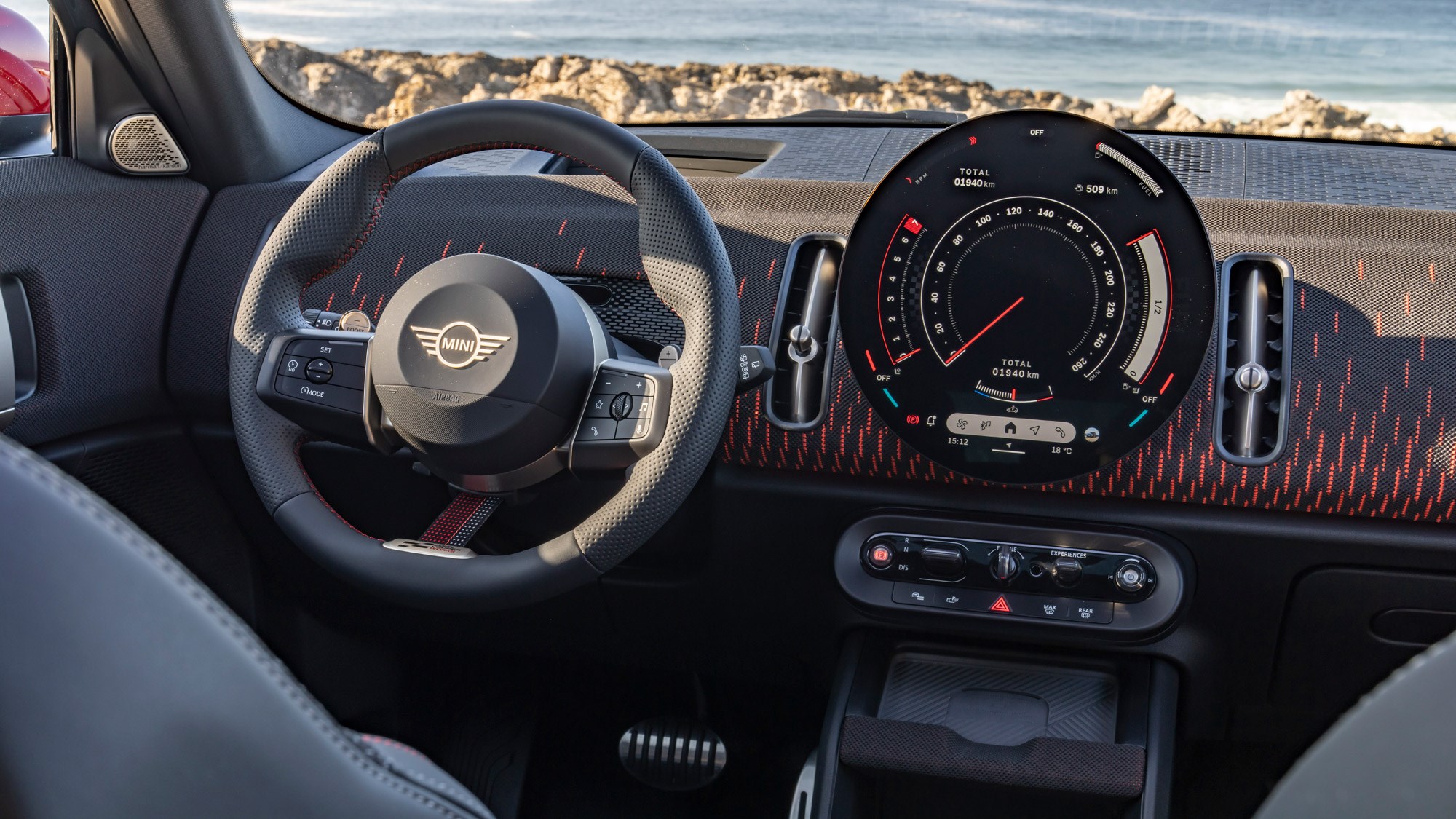
As such, they significantly alter the digital appearance of the central display – not always for the better – and use the Mini Projector that’s optionally fitted behind this to cast colours and patterns onto the dashboard as an extension of the more conventional ambient lighting.
The OS9 upgrade, meanwhile, brings apps to the infotainment in a much more substantial way. Mini is apparently preparing us for a future without much in the way of actual driving, since these are focused on entertainment that includes video streaming and multi-player gaming. This last is deployed in a limited and slightly kitschy way, but the system works and it’ll keep you occupied at a standstill.
What are the specs?
There are three turbo-petrol Countrymans coming to the UK, plus a couple of electric variants we’ll cover separately.
So far we’ve driven the range-topping John Cooper Works. With 2.0 litres, 296bhp and 295lb ft constrained by ALL4 all-wheel as standard, this claims 0-62mph in 5.4sec, 155mph top speed, 34-36.2mpg and 177-188g/km CO2. Speed isn’t an issue here.
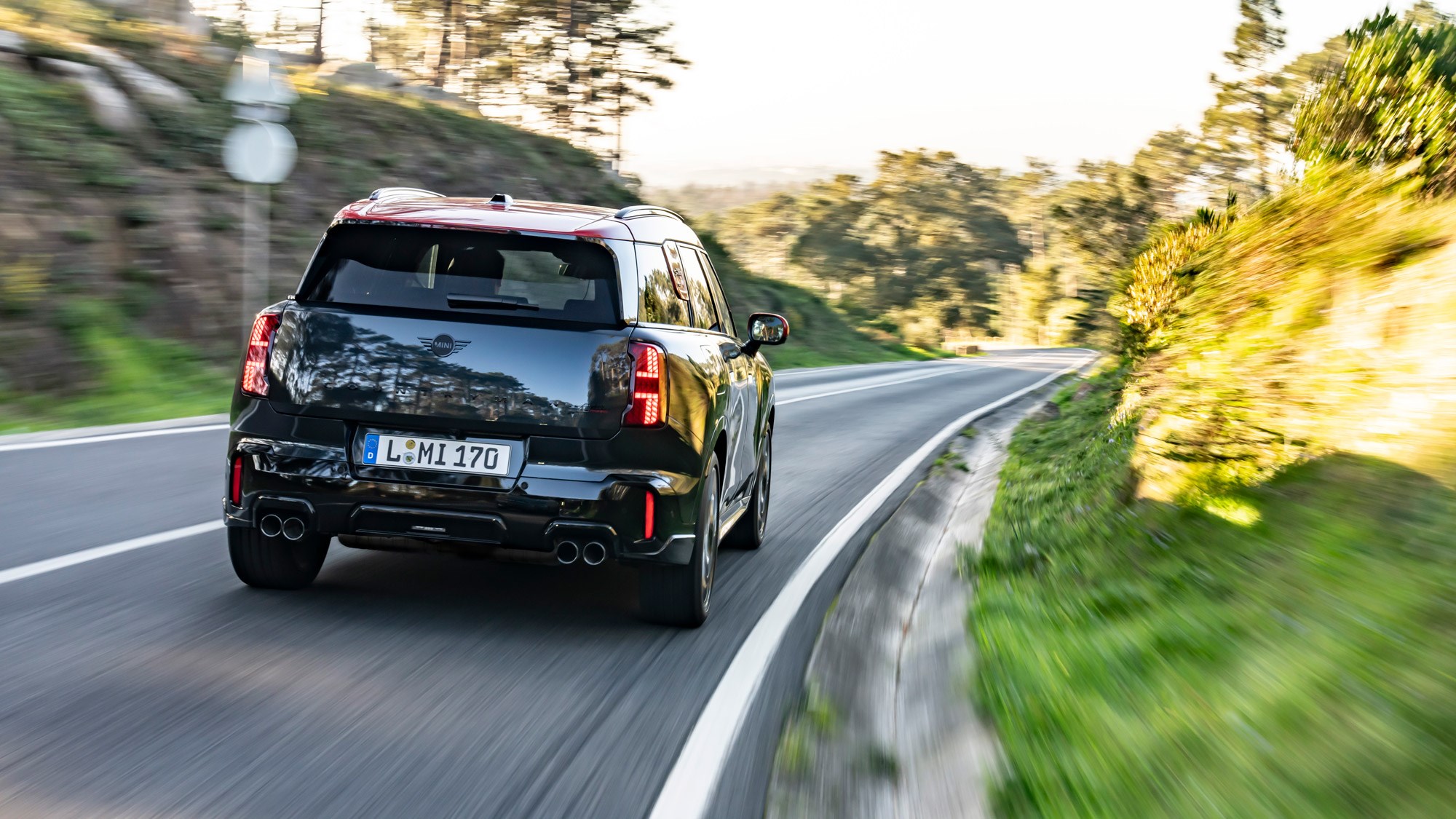
Below this sit the entry-level Countryman C and the mid-range Countryman S. The latter is a 215bhp / 265lb ft 2.0-litre with ALL4 all-wheel drive, claiming 0-62mph in 7.1sec, 142mph, 38.2-41.5mpg and 155-169g/km.
The C is a front-wheel drive 168bhp 1.5-litre triple with 206lb ft, 0-62mph in 8.3sec and a top speed of 132mph. It’s the most efficient model, but not by that much, claiming 40.9-46.3mpg and 138-155g/km.
All third-generation Countryman models come with a DCT automatic gearbox, though there are some differences between models. The JCW gets the Sport version as standard, for faster shifting.
How does it drive?
The John Cooper Works is quick and keen and a little cartoonish. The steering is super-sharp, but isn’t the last word in precision – making it fine for fast, flowing driving but not that effective if you overcook your entry speed and need to make an abrupt correction.
Compared with most mid-sized SUVs it’s still light on its feet and there’s plenty of grip, so the occasional mistake is unlikely to lead to instant disaster. It’s just that the inevitably upright stance and extra bulk blunts the edge a bit, and you won’t be tucking this into a late apex in quite the same manner as a Mini hatchback.
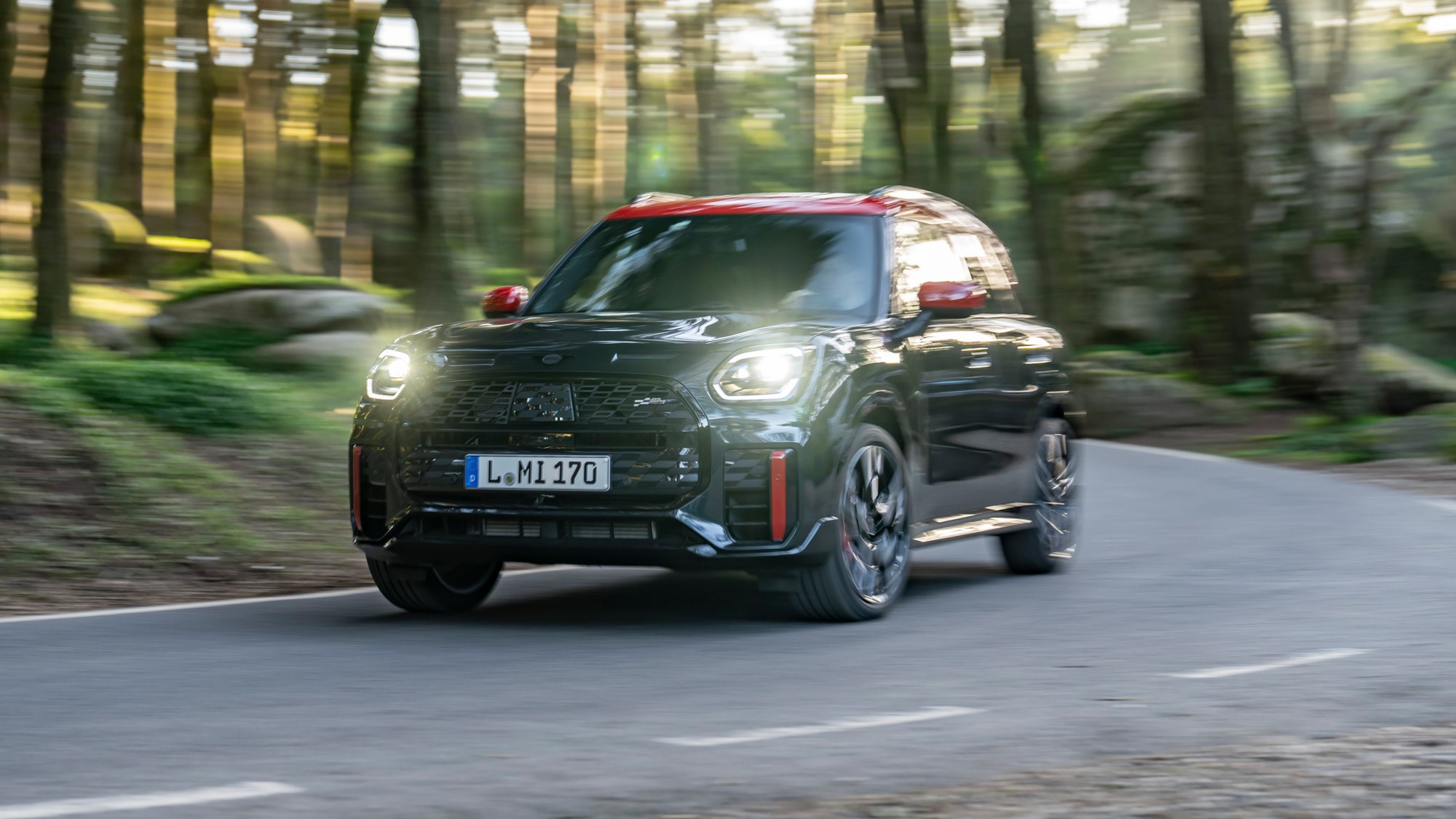
Similarly, the 1.8m+ width and near 1660kg heft makes it a less of an arrow and more of brick when the roads turn narrow and sinewy. The launch route in Portugal bravely took in a host of off-camber turns, often following immediately after a blind crest and complicated by a surface repatched more than VW’s ID software; in these circumstances the inclination is most definitely in the direction of slowing down rather than scruffing any necks, a decision made easier by the firmness of the suspension.
The JCW gets ‘adaptive’ dampers as standard, but these are self-regulating via internal valving and not something you get to have any say over. It thumps and bumps its way over bad tarmac regardless, and while not as uncompromising as some other models in the BMW group portfolio is certainly hard for a family SUV. This is by far the most tiring aspect of the driving experience, and undermines the fun rather than adds to it.
The engine’s a little coarse but goes well, and we don’t doubt that in combination with the self-shifting transmission and four-wheel drive it can easily manage that quoted 5.4sec 0-62mph time – 155mph feels well within reach, but not on a Portuguese highway.
What about the interior?
The artificial engine noise is a bit much for our tastes – but on the flip side, even with four exhaust pipes the JCW sounds muted without it. Mini makes it easy to switch between the two states, however, as one of the few remaining buttons in the cabin takes you to a driving settings menu on the central display. Here you’ll also be able to turn off the speed limit exceeded warning beep…
That round screen might seem gimmicky, but it’s actually a decent piece of interior theatre and beautifully crisp. Some of the Experience Modes make a slight mockery of this with poorly legible graphic changes, so it’ll be interesting to see how many buyers actually bother to shift between them regularly.
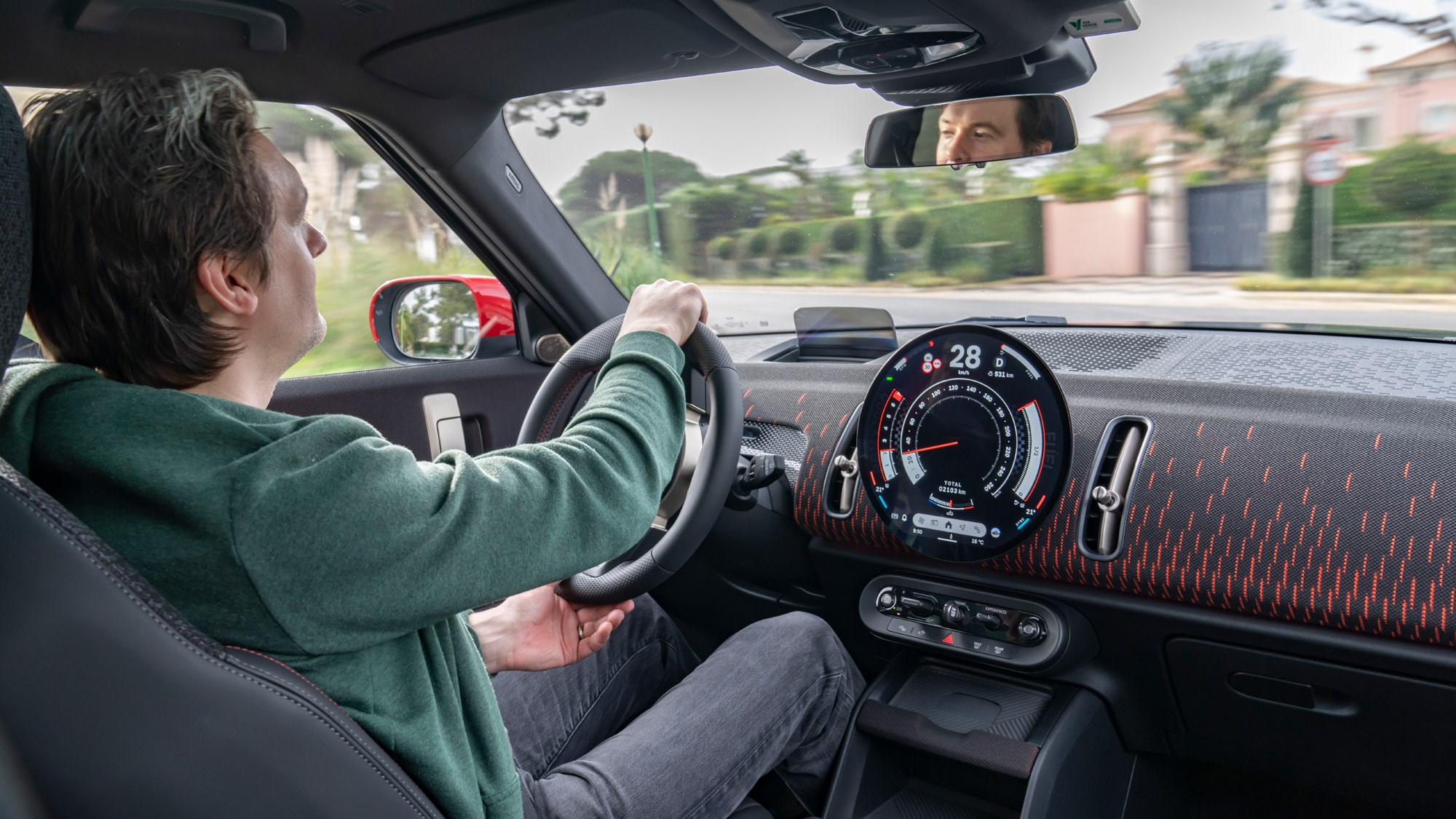
The sound effects that accompany the changes are definitely gimmicky, as are the cartoon Mini and dog avatars you can choose between for the Mini Assistant voice control. Shades of Clippy here, but that’s a reference probably lost on Mini’s young and trendy audience. Etc.
The knitted dashboard finish is distinctive, though the colour choices may be too wild for some and we can’t help thinking the crevices are going to be hell to keep clean. The strap that represents the third spoke on the sports steering wheel is also an unusual feature, albeit perhaps a more universally likeable one.
The seats are comfy and supportive, the rear is spacious enough (the bench slides fore and aft 13cm to balance leg room against the boot), and quality feels robust. The boot ranges from 460 litres with maximum passenger space to 1530 litres with the rear seats folded, though some of that is hidden under the floor. The lip is also quite high, which families with heavy baby buggies might want to think about.
The infotainment is reasonably easy to get a handle on. In typical modern BMW/Mini Operating System style, it’s simple at the top level, becoming increasingly complex and powerful the further you delve into the menus. While the smartphone-like approach should make for a gentle learning curve for most users, as ever we rue the decision to dump so many of the climate controls into the digital environment. Adjusting the temperature is a particular chore now. Shame.
Before you buy
The Countryman JCW comes only in Sport specification – and even then has a number of bespoke features that separates it from Sport versions of the Countryman C and Countryman S.
These two models are also available in lesser Classic and Exclusive trim levels (Mini calls them ‘styles’). All are well equipped and, as you’d probably expect these days, options are largely bundled into packs to make WLTP calculations easier.
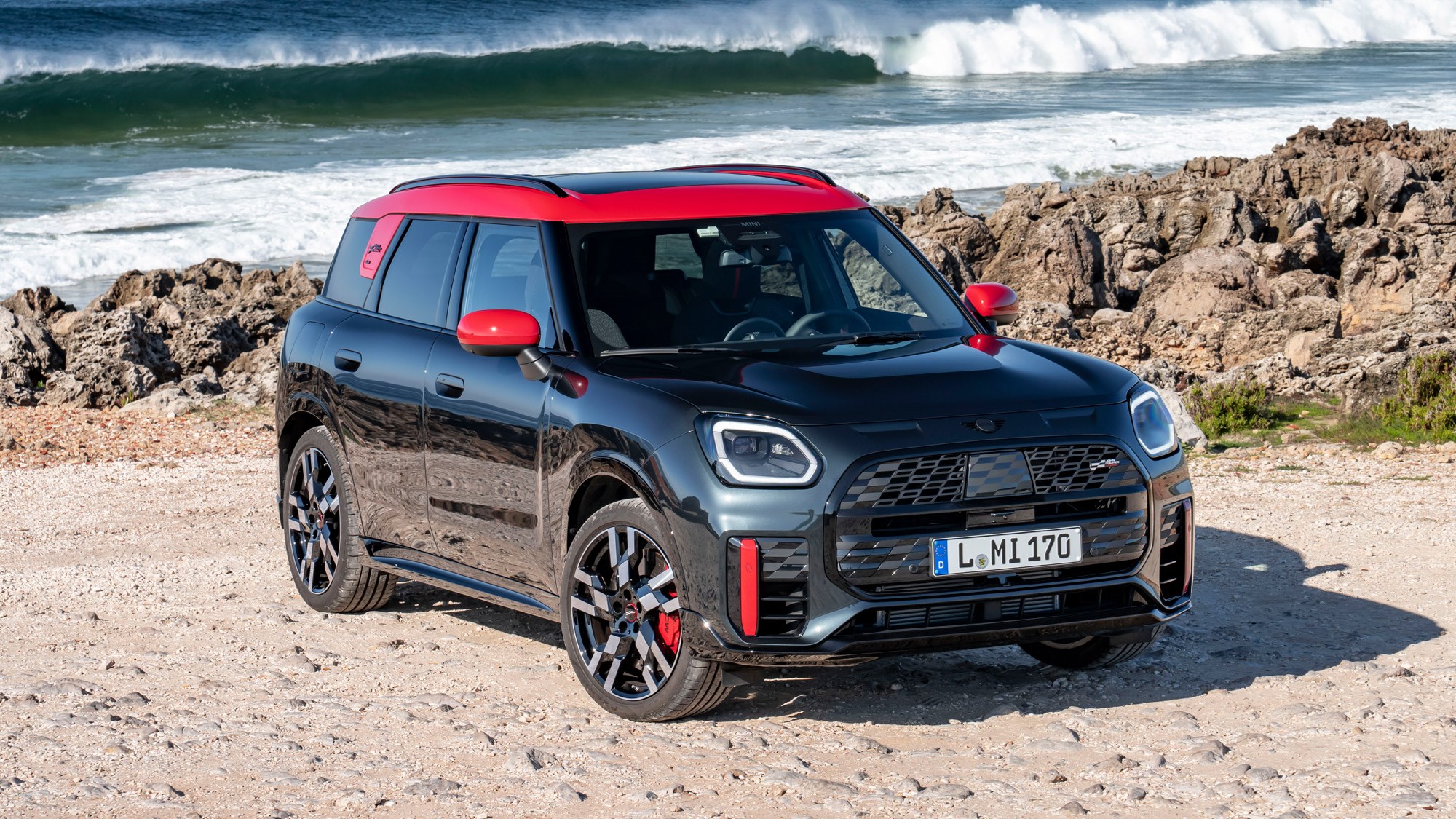
Compared with the obvious Cupra Ateca and VW T-Roc R rivals, Mini brings a different kind of spirit. As such, the burgeoning performance family SUV market increasingly caters to a wide range of tastes: the Cupra’s unusual colour palette reminiscent of a modern boutique hotel, the Mini majoring on cheery fun, and the VW tailored to a more conservative audience.
The JCW is also good value versus this competition. With a launch price of £40,425 it’s a useful few thousand pounds less for very similar performance and capabilities.
Mini Countryman John Cooper initial verdict
Lots to like here, but some irritating gripes. Once again a carmaker has put style above functionality when it comes to some pretty important interior controls – although voice activation can take some of the sting out of this it still seems like poor ergonomic thinking. And for a family car, the Countryman JCW delivers a pretty bumpy ride.
However, the quality is good, performance is strong and compared with the competition the JCW is attractive value. Practicality has improved and it’s still fun to drive. So if you’ve a strong back and a clear speaking voice it’s well worth further consideration.